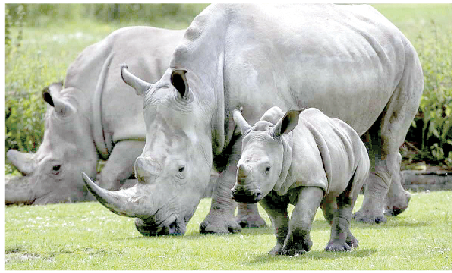Kenya ranks third globally in rhino count, says KWS

Kenya ranks third with the highest number of rhinos in the world, a feat attributed to reduced levels of poaching of iconic species by over 90 per cent in the last six years.
According to the Kenya Wildlife Service (KWS), the rhino population stands at more than 1,000—the third largest country population in the world. South Africa and India take the top two spots.
KWS revealed that the country ranks position four in elephant population at more than 34,000.
Botswana remains the continent’s elephant stronghold, with 130,000 animals, concentrated along the Chobe and Savuti River systems in the north and in the vast wetland oasis of the Okavango Delta.
Zimbabwe showed the second highest number of elephants—83,000—mostly along the Zambezi River and in Hwange National Park.
Overall, Zimbabwe’s elephant population has dropped 10 per cent since 2005.
Tanzania ranks third with a population of 32,871 elephants.
Punitive laws
In a statement on the status of elephants and rhinos in the country, KWS Director General Brigadier (Retired) John Waweru attributed punitive laws as the reason for drop in poaching.
“The Wildlife Conservation and Management Act, 2013 was amended in 2019 to provide for more punitive measures for wildlife offences,” said Waweru.
Waweru said elephant poaching trend has been on the decline, adding that in 2012 there were 384 elephant poaching cases but in 2018 the number went down to 38.
“The same has been recorded in rhino poaching where in 2012, there were 30 rhino killed and the number has reduced to a single digit of four in 2018,” said Waweru.
He added that to prevent and combat wildlife crime, and in particular poaching and trafficking in wildlife species and their products, KWS has established and strengthened specialised security units.
They have been deployed throughout the country, which include the Canine Unit that helps sniff wildlife products/tracking wildlife offenders and Prosecution Unit for wildlife-related offences.
“To strengthen law enforcement, KWS works very closely with other law enforcement agencies in all matters of wildlife security at local, regional and international arena,” he added.
Threat to wildlife
Waweru, meanwhile, said though progress has been made, the country’s wildlife insecurity is characterised by international trade in trophies and meat, commercial poaching for bush meat and illegal wildlife trade.
“Human wildlife conflicts, bush meat trade and commercial poaching remains a substantial threat to wildlife conservation in Kenya and in the region,” he said.
Unfortunately, Waweru said, Kenya is a key transit hub within the region to international destinations. “Various wildlife products, mainly elephant ivory, rhino horn, pangolin scales are transited through our ports,” he said.
He said the application of strong and deterrent prison sentences have worked well to reduce poaching.
Regional collaboration
He added that regionally, cross-border collaboration with Tanzania has been in existence for more than two decades.
Similar collaboration with Uganda is also being strengthened to address crimes of trans-border nature.
Interpol and Lusaka Agreement Task Force are instrumental in facilitating, coordinating and offering support where crimes of international nature occur.
To end human-wildlife conflict, Waweru said KWS has engagement forum with community to win the support in enhancing wildlife security.
“This initiative has focused on the youth, local elders and women especially in the Laikipia/Samburu ecosystem. As a result, elephant poaching and retaliatory killings have greatly reduced and the community is now sharing information with KWS,” he said.















